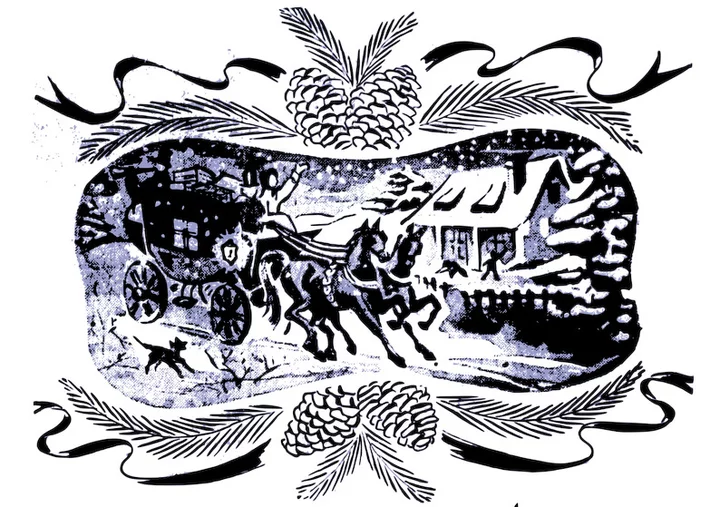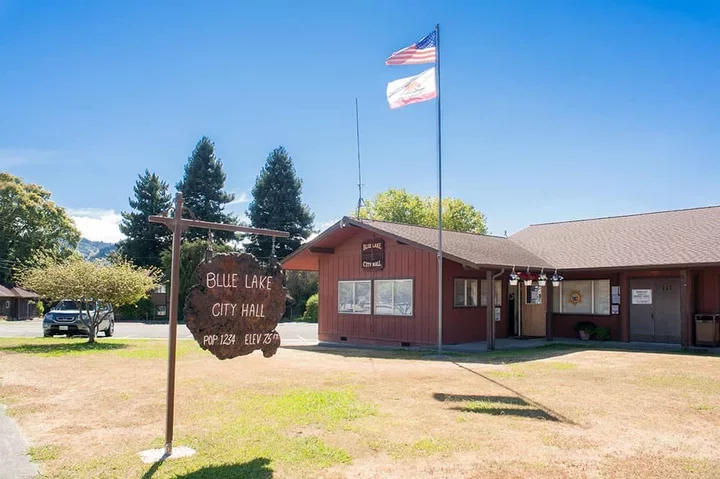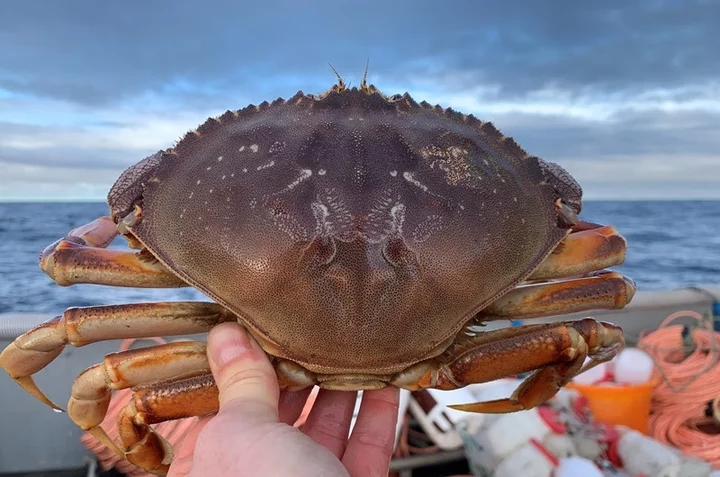HUMBOLDT HISTORY: Let Charity Sweeten the Chalice
Bret Harte / Saturday, Dec. 20 @ 7:30 a.m. / History
NOTE from the HUMBOLDT HISTORIAN: This editorial appeared in the Northern Californian on December 21, 1859, at the time when Bret Harte was employed on this paper. It was reprinted in the Newsletter (the predecessor of the Humboldt Historian) in December 1956, with a note from Martha Beer Roscoe that stated, “We are convinced, through stylistic evidence, and through comparison of it with articles known to have been written by Bret Harte during this period, that this editorial came from his pen. We have read many excellent editorials written by the able, but matter-of-fact Colonel Whipple, and so feel reasonably sure that this could have been written only by Bret Harte.”
###
The annual season of festivity and enjoyment is at hand. Not as of old, with its crisp snow, its ringing sleigh bells, its icy airs, its bewildering shows, and fascinating shop windows. Not as remembered by the western wanderer in his memories of eastern homes, yet blessed as the anniversary of such memories. A few weeks, and old Christmas will be laid away in one of Time’s niches, as carelessly as its broken toys, and favored gifts, no longer new, are tossed upon the closet shelf. But we pity the man who can look back on such days without regret, or can open the dark closet of his memory without a sigh over its broken baubles. We have a proper respect for manliness, yet how many of man’s full-grown hobbies have their shattered prototypes on those same forgotten shelves!
It’s an old saying that “Christmas comes but once a year.” Take it as a popular excuse for an annual Saturnalia, for the unrestricted indulgence of animal appetite, for gluttony and drunkenness, and let us be thankful that it comes but “once a year.” But take it as the blessed mediator of estranged affection, recalling the past, reviving old loves and friendships and kindling and awakening new; bringing friendliness and generosity, “peace on earth and good will towards men;” recalling in deed as well as name the advent of the meek and holy One — and heaven knows it comes too seldom!
Here in this favored land, in the new homes you have built, in the land of strangers and wanderers, in the region of “tarrying,” of inquiet and unrest, as you gather round the social board, — “THINK OF THE ABSENT!”
Think of the ties, once sacred, broken and disregarded. Think of the friendships that have grown cold by neglect and absence. Think of the distant ones, whose hearts might have been gladdened by slight remembrance, or the potent magic of a kindly letter. Think of them at their best. The old true faith, the honest simple hearts, unchilled by fortune, and unchanged by time.
Sons and daughters, think of the gray heads and bowed figures in different lands — but close to the one undefined country — think of the dim eyes that gaze wistfully at the vacant chair, and the trembling lips and broken accents that couple your name with a parent’s blessing. Parents, think of the unexperienced souls launched on the ocean of Life, — how many have been sucked into the giddy vortex of deceit and folly, how many have foundered in sight of port, how many tossed about by contending elements, rudderless and alone, lit up by fiery passions, have drifted like a blazing ship, into outer darkness. Think of the snares that trip the nimblest feet, and how the fatal sisters’ shears have severed many a silken thread on which your neighbor wove the web of future fancy. Think how the great white shore of Eternity, with its bleaching skeletons of mighty ships, is yet strewn with the wreck of many a fairy shallop.
Think of those who have no home. Think of those who have no kith or kindred. Think what it is, at such a season, to sit alone, apart from the sacred circles, with no fellowship or sympathy, isolated and secluded, with no gentle hand to touch the heart strings, no one to know its secret compass, no one to draw out its hidden latent melody. There are such around you everywhere. Every little hamlet in California contains such strange and voiceless heart-chords, unknown, unswept, but not unmusical.
Think of this at the recurrence of each festivity. Then “eat, drink, and be merry.” We are not moralizing, nor do we hold ourself strictly “virtuous;” nor would we keep any from their “cakes and ales,” but we believe that the feast leaves no headache behind, when Memory sits at the board and Charity sweetens the chalice.
###
The piece above was printed in the Winter 1997 issue of the Humboldt Historian, a journal of the Humboldt County Historical Society. It is reprinted here with permission. The Humboldt County Historical Society is a nonprofit organization devoted to archiving, preserving and sharing Humboldt County’s rich history. You can become a member and receive a year’s worth of new issues of The Humboldt Historian at this link.
BOOKED
Today: 2 felonies, 6 misdemeanors, 0 infractions
JUDGED
Humboldt County Superior Court Calendar: Today
CHP REPORTS
1500 MM36 E HUM 15.00 (HM office): Mud/Dirt/Rock
1656 Union St (HM office): Closure of a Road
ELSEWHERE
RHBB: Large Redwood Falls Across Mattole Road Near Honeydew, Blocking Traffic
RHBB: Ina Watson: ‘As beautiful on the inside as she was on the outside’
RHBB: Vehicle Overturns on Highway 101 Near Loleta
KINS’s Talk Shop: Talkshop December 26th, 2025 – Jenn Capps
Blue Lake Set to Appoint Civil Engineer, Third-Generation Local Jennie Short as Next City Manager
LoCO Staff / Friday, Dec. 19 @ 5:38 p.m. / Local Government
Blue Lake City Hall. | Image via the City of Blue Lake.
###
Press release from the City of Blue Lake:
At their regular December 23, 2025 meeting, the Blue Lake City Council will consider the selection and appointment of Jennie Short as the new City Manager. Should the Council move forward, Ms. Short will take over from interim City Manager Jill Duffy who has served the city since last August. The leadership transition is expected to commence on January 5, 2026.
I am excited that the Council will have the opportunity to consider Ms. Short for City Manager and, if so appointed, I am confident that she will be an excellent leader for our City and our residents” said Mayor John Sawatzky.
The recommendation of Ms. Short follows a robust recruitment process lead by the City Council with the help of an ad hoc committee and independent recruitment firm over the past five months. With nearly three decades of experience in engineering and project management, Ms. Short has a proven record of managing in infrastructure projects that have improved essential services such as water supply, sewer collection and treatment, airports, and transportation. Her knowledge in regulatory compliance, fiscal management, and enterprise fund financial management further enhances her ability to advance the city’s objectives while maintaining transparency and accountability.
Ms. Short grew up in Blue Lake and graduated from Chico State University with a bachelors of science in Civil Engineering. She has worked as a civil engineer with the State of Oregon’s Department of Transportation, the US Forest Service, the City of Roseburg, Del Norte County and the local consulting company 4J’s Consulting. Following a return home to Blue Lake in May 2007 she has served on the city’s Parks and Recreations Commission and the Blue Lake/Fieldbrook Little League Board of Directors.
“As a third-generation Blue Laker, I cherish this special community and the charming characteristics that embody Blue Lake.” States Ms. Short. “It is an honor to be in a position where I can utilize my unique skill set to enhance core services such as infrastructure, public safety, and financial stability. I am grateful for this opportunity and, if appointed, look forward to working with the council, staff, and residents to achieve our common goals.”
‘I Want Our Officers to Have Skin in That Game’: New APD Chief of Police Chris Ortega on the Importance of Community Engagement and Culture
Dezmond Remington / Friday, Dec. 19 @ 3:31 p.m. / Public Safety
Chris Ortega. Submitted.
Google “Chris Ortega APD” and see what comes up. After the first dozen results that announce his ascension to head of the Arcata Police Department, what pops up is a never-ending series of press releases, news articles, and videos that catalogue crime after crime after crime that he commented on. Seemingly every human sin has an entry in the lineup.
Of course Ortega has seen plenty of lawlessness; he’s been an officer since 2005. But his experience with the subject runs deeper than simple resume material.
Ortega, 47, was sworn in last week as APD’s Chief of Police after sharing the position with the former chief Bart Silvers for the last three months. He’s held a lot of roles for the APD over the last 20 years, becoming a sergeant in 2016 and a lieutenant in 2024. He’s been on the Drug Task Force, the Major Crimes Task Force, and the Sexual Assault Response Team. He’s also worked as a detective and a background investigator.
Ortega wound up in Humboldt when he was restoring streams and doing trail work for the California Conservation Corps in the late ‘90s. Fresh off of a Greyhound from the Imperial Valley, he was struck by the beauty of the forest. Near the end of his career with the CCC, while supervising a crew in the Headwaters Forest Reserve, he thought about how he’d never again be able to enjoy an office like that one. He was outside, and he was mobile.
It was a long way from growing up impoverished in El Centro. Gangs roved through his neighborhood and fought constantly. Thieves broke into his childhood home several times — he once watched his mother use a baseball bat to fend off someone trying to jimmy open a window. She called the police. The authorities never found the burglar, but a young Ortega was impressed by their ability to act as a group and their willingness to show up to a stranger’s house and risk themselves defending them.
“And as a child, that’s formative,” Ortega told the Outpost. “And I’m looking at people that are doing this. They’re in uniform, they’re cohesive, they’re a team. They look like me. And I’m just like, ‘I want to do that. I want to be able to do that for somebody else.’”
Dealing with budget problems, California laid off CCC members in 2004. Ortega wanted some stability and decided it was time to go into law enforcement. It ended up being similar to restoration work, with its physicality, its mental challenges, its variety. He was still outside no matter the weather; he still had a team to work with.
The importance of the team cannot be overstated.
“Your community is asking you to risk your health, to risk your safety, to risk your family’s well-being,” Ortega said. “The community is asking you to do this for 20 to 30 years. You’re going into volatile situations. You’re there because the situation is already out of control, and you’re showing up with a group of people that you have to be very tight with in order to navigate these things.”
“I have probably hundreds of stories of that very dynamic taking place, but I’m focusing on the dynamic itself,” he continued. “What keeps me in this profession, what keeps us in this profession, is that camaraderie that you have when you have skin in the game and you’re out there trying to better the community.”
Pinning down what Arcata wants from APD isn’t always easy. Generally, Ortega said people want relief from the quality of life issues that breed nuisances like public intoxication, fighting, and shoplifting; he said he heard an “outcry” for a safer community.
Combatting fears about the Trump administration’s aggressive deportation campaign is part of that. Ortega takes it seriously. APD has been working with Centro del Pueblo to connect law enforcement with community members, answering their questions and assuaging their fears.
Ortega, himself a Spanish speaker, was praised by Arcata’s mayor Kimberley White when his selection was announced in October. She told a story about a town hall meeting this year about Arcata’s status as a sanctuary city. Ortega spoke with a woman who didn’t speak much English; she started crying.
“At first, I was like, ‘Uh oh.’ And then I realized that these were tears of relief and happiness,” White said. “Because she knew during these tumultuous times that she can depend — and we can all depend — on Lieutenant Ortega.”
A few other people took the opportunity to praise Ortega effusively at the meeting for his empathy when they needed him.
Outreach is high on Ortega’s list of priorities; he plans on hiring an engagement specialist. The more he was promoted, the less he got outside and met people, one of his favorite parts of the job. Ortega thinks it important to make frequent face-to-face contact with people, making sure they know they all share common ground and values. Taking an occasional walk around the plaza or in Valley West scratches that itch and lets him strengthen the bond between Arcata and the department.
It can be a tenuous one. Over the summer, pro-homeless advocates for campers living on private property picketed garbage cleanups. There was no way APD was going to let them stay. The owner requested APD’s help removing them, and so for almost six months officers and homeless services providers spread the word that they’d have to go eventually. The conflict boiled over into raucous city council meetings and protests over encampment sweeps that weren’t happening.
Ortega attributes the disconnect to simple ignorance of the situation; APD, of course, must enforce trespassing laws if they’re asked to.
He does not plan on directing officers to fine every broken taillight; it’s not worth upsetting and inconveniencing residents just to nab the occasional fine. The culture Ortega’s cultivating for his officers is, he hopes, something that will keep new hires there. Making people feel like they’re valued, like they’re part of an organization and a community worth belonging to has been important for Ortega and the last few chiefs.
“I encourage our [officers] to engage in servant leadership where they’re leading by example,” Ortega said. “If we’re having problems in a certain area of town that are going to require our officers to go and make contacts, potentially make arrests, potentially get into foot pursuits and potentially have to fight people, [then] I want our I want our officers to have skin in that game.”
The APD has struggled with staffing in the past (they’ve consistently been a few people down for a few years), but in about a year all of their officers-in-training will be finished and ready to work. A $50,000 bonus to attract laterally transferred officers doesn’t hurt either.
Balancing the needs of the department and Arcata’s needs is difficult, he said, but it’s important to remember that everyone involved in the dance between the authorities and the community is a human being.
“I’m going to listen before I act,” Ortega said. “I’m going to support our people while holding ourselves to the highest professional standards, and I’m going to work hard every day to earn our community’s trust.”
‘A Critical Investment’: City of Eureka Nabs $3.3 Million State Grant for Everding Community Center
LoCO Staff / Friday, Dec. 19 @ 3:20 p.m. / Community
A digital rendering of the Everding Community Center at 3114 Prospect Ave. | Image via the Housing Authority of the City of Eureka (HACE)
###
The City of Eureka was recently awarded a $3.3 million grant from the California Department of Housing and Community Development (HCD) to build the Everding Community Center, which will house programming for the Boys & Girls Club of the Redwoods. The community center will double as an emergency shelter during extreme weather events.
Additional details can be found in the following press release from the Housing Authority of the City of Eureka:
EUREKA, CA – The City of Eureka has been awarded Community Development Block Grant (CDBG) funding through California’s Department of Housing and Community Development (HCD) as part of Governor Gavin Newsom’s announcement of $52 million in federal grants to revitalize communities statewide. The funding will support the development of the Everding Community Center, a cornerstone project in the Housing Authority of the City of Eureka’s (HACE) comprehensive Everding Repositioning initiative, developed in partnership with Brinshore Development and Operative Office.
Eureka was named among six California communities receiving public facility improvement grants, which together total $18 million. The award recognizes the transformative potential of the Everding Community Center to serve one of Humboldt County’s most underserved neighborhoods.
About the Everding Community Center
The Everding Community Center (ECC) will serve as the hub of a comprehensive redevelopment serving Census Tract 3, designated as a “disinvested” community under California Jobs First criteria. The facility will house programming by the Boys & Girls Club of the Redwoods (BGCR), providing critical services to youth and families in the Everding neighborhood and surrounding public housing communities.
The ECC is designed as a net-zero, carbon-neutral building featuring rooftop solar panels, all-electric appliances, energy-efficient windows, and sustainable design elements. Beyond serving as a youth and community programming center, the facility will enhance regional disaster resilience by providing emergency shelter capacity during extreme weather events.
Integrated Housing Development
The Everding Community Center serves as the linchpin of HACE’s larger Everding Repositioning masterplan, a nearly $100 million comprehensive redevelopment of the agency’s public housing portfolio. The ECC will be constructed in coordination with adjacent affordable housing developments, including the Green Phase (142 units) and the Blue Phase (44 senior housing units), creating an integrated community where residents have immediate access to services and programming.
“This funding represents a critical investment in our community’s future,” said Cheryl Churchill, Executive Director of HACE. “The Everding Community Center will provide essential services to our residents while demonstrating how public-private partnerships can create lasting, positive change in underserved communities. We are grateful to Governor Newsom and HCD for their confidence in this project.”
Development Partnership
The Everding Repositioning is being developed through a partnership between HACE, Brinshore Development, and Operative Office. This collaboration brings together local leadership with specialized expertise in affordable housing development, ensuring that project control and decision-making authority remains with Humboldt County entities while leveraging best practices from successful developments nationwide.
“This investment allows us to deliver more than a building—it helps create a resilient, service-rich community for Everding residents,” said David Brint, Co-founding Principal at Brinshore Development. “We’re proud to partner with HACE and Operative Office to strengthen affordable housing and expand opportunity in Humboldt County.”
The development team has secured multiple funding commitments for the broader project, including historic tax credit allocations from the California Debt Limit Allocation Committee (CDLAC), demonstrating strong state confidence in the project’s viability and community impact.
Community Impact
The project will directly benefit over 230 public housing residents and 100 youth served by BGCR, with 99% of BGCR students qualifying for free or reduced-price lunch. Construction will provide employment opportunities for local workers, with priority hiring from the community.
The BGCR serves a significantly more diverse population than Eureka’s overall demographics, with programming designed to support young people from priority communities. By providing quality, affordable childcare and youth services, the ECC will enable parents to pursue employment opportunities and contribute to the region’s economic vitality.
Statewide Initiative
Governor Newsom’s announcement included 90 projects across 53 California counties, funded through federal Community Development Block Grants and Emergency Solutions Grants. HCD Director Gustavo Velasquez noted that “the CDBG grants awarded this year will foster improved quality of life for low-income Californians in rural communities in every corner of the state.”
The Eureka award aligns with the state’s commitment to supporting integrated housing and community development projects that address multiple needs simultaneously—from affordable housing and youth services to climate resilience and economic opportunity.
###
Commercial Crabbing Can’t Start Locally Until at Least Jan. 15, Says California Department of Fish and Wildlife
LoCO Staff / Friday, Dec. 19 @ 2:01 p.m. / Fish
Photo: CDFW.
From the California Department of Fish and Wildlife:
The California Department of Fish and Wildlife (CDFW) will open the commercial Dungeness crab fishery in the Central Management Area (Sonoma/Mendocino County line (38°46.125’ N. latitude) to Point Conception (34°27’ N. latitude)) beginning Jan. 5, 2026, at 12:01 a.m., with pre-soak to begin on Jan. 2, 2026, at 8:01 a.m. This area (Fishing Zones 3, 4 and 5) will be subject to a 40% trap reduction. The trap reduction is expected to reduce entanglement risk for humpback whales by decreasing the number of vertical lines attached to traps in the water.
The Dungeness crab season in the Northern Management Area (Fishing Zones 1 and 2, California/Oregon border (42° N. latitude) to the Sonoma/Mendocino County line) will be further delayed pursuant to Fish and Game Code Section 8276.2 because of the inability to conduct meat quality testing due to elevated levels of domoic acid. Pending results of ongoing domoic acid testing, the season will open on Jan. 15, 2026, at 12:01 a.m., under a 15% trap reduction in both Fishing Zones. A pre-soak period will begin on Jan. 12, 2026, at 8:01 a.m. The crab quality delay triggers the fair start provision under Fish and Game Code Section 8279.1. Under fair start a vessel is prohibited from taking, possessing onboard or landing crab in an area previously delayed for a period of 30 days from the date of the opening if that vessel previously participated in other commercial Dungeness crab fishing areas (including those in Oregon and Washington) during the same season.
Opening the commercial crab fishing season under a trap reduction strikes a balance between the needs of the commercial fishery and the protection of humpback whales which remain in areas that overlap with key fishing areas off the California coast.
“Setting the opening date of the Dungeness crab fishery is never easy. The commercial Dungeness crab fishery is inherently complex, and careful consideration is required to ensure we are supporting California’s fishing communities while also reducing risk of entanglement of whales and sea turtles off our coast,” said CDFW Director Charlton H. Bonham. “CDFW is grateful for the collaborative effort between commercial and recreational fishermen, environmental groups, scientists and agency partners that support our work in managing this iconic West Coast fishery.”
Trump Administration Intervenes in Potter Valley Dam Removal, as Department of Agriculture Asks FERC to Halt Decommissioning Process
Hank Sims / Friday, Dec. 19 @ 12:47 p.m. / Environment
Cape Horn Dam. Photo: PG&E.
###
The two broken dams on the Upper Eel River found a powerful champion this morning, after the United States Department of Agriculture filed a motion to intervene in Federal Energy Regulatory Commission proceedings that would see them removed.
The department’s filings today follow Secretary of Agriculture Brooke Rollins’s letter to the editor published in the Mendocino Voice last week, in which Rollins told Potter Valley farming interests that they were “not alone in this righteous fight, which strikes at the very heart of our freedoms.”
The dams — together known as the “Potter Valley Project,” and owned by Pacific Gas and Electric — have been unable to generate power for many years, which is the purpose they were built for a century ago.
In the last few years, Rep. Jared Huffman has led efforts to form a compromise “two-basin solution” that would allow for continued diversion of water from the Eel to the Russian River, supporting agriculture and population in Mendocino and Sonoma counties.
When that was completed — and after local tribes, environmental organizations, Humboldt County and the principal water agencies in both Mendocino and Sonoma all signed on — PG&E officially filed a decommissioning plan with FERC in July 2025.
But chapters of the Farm Bureau in communities along the Russian River have stood in dissent, and have communicated their displeasure to the Trump Administration — as has the government of Lake County, which is home to Lake Pillsbury, the reservoir behind one of the dams.
Now, with the official intervention of the Department of Agriculture, it appears their pleas have been heard. Writing for the department, Tucker A. Stewart, senior advisor to Secretary Rollins, argues on a number of fronts that FERC should deny PG&E’s application to remove the dams, at least in its current form.
Though the department’s principal concern appears to be protecting farmers and ranchers, especially those in the Potter Valley region. But it also makes a number of arguments about the decommissioning plan’s effects on firefighting, recreational opportunities and reforestation. (Read the full letter here.)
Stewart concludes:
It is abundantly clear that PG&E’s application fails to consider appropriately the elimination of water supply to local communities without viable alternatives; the negative impact that removal will have on downstream communities and agricultural producers; and the diminished capacity for wildland firefighting in one of the most fire-prone regions of the country. Unless and until PG&E addresses the aforementioned issues included in these comments, the Department respectfully requests that the Commission reject PG&E’s application to surrender its FERC license for Potter Valley Project dam because of the profoundly negative and irreversible impact on local farmers, ranchers, agricultural producers, communities, and USDA equities.
Reached this afternoon, Scott Greacen, conservation director for Friends of the Eel, told the Outpost that the department’s ask of FERC appears to be to force PG&E to continue to maintain the dams — an option he argued was forbidden under federal law.
“The Federal Power Act expressly forecloses that at as an option,” Greacen said.
Back in September, when Rollins first started tweeting about the Potter Valley Project, Rep. Huffman, in an interview with the Outpost, argued that political intervention in the proceedings would only harm the people the administration was attempting to help.
“When you have the ability to order federal agencies to do things for purely political reasons, you can definitely slow things down,” Huffman said. “That’s my sense of what this means. And, you know, who’s hurt the most by that? Ironically, it’s the people in Potter Valley and in the Russian River Basin, because it delays the water supply solution that is the only way their needs are going to be met.”
DOCUMENTS:
- USDA’s “Notice of Intervention,” filed with FERC on Dec. 19, 2025.
- USDA’s Arguments Against the Decommissioning of the Potter Valley Project, filed with FERC on Dec. 19, 2025.
PREVIOUSLY:
- Lake County May Try to Derail Eel River Dam Deal With Direct Appeal to President Trump
- Farm Bureaus in Russian River Counties Issue Plea to President Trump to Keep the Potter Valley Dams in Place
- Humboldt Supervisors OK Potter Valley Water Diversion Plan, Paving the Way for Eel River Dam Removal
- PG&E Files Its Application to Surrender its Hydropower License, Paving the Way for the Removal of the Potter Valley Dams on the Eel River
- Trump Administration Slams Eel River Dam Removal Plan, But Huffman is Confident the Project Can’t Be Stopped
Minor Flooding Reported Around Humboldt Bay; More Rain En Route
Isabella Vanderheiden / Friday, Dec. 19 @ 12:44 p.m. / How ‘Bout That Weather
Freshwater Creek flooding Howard Heights Road this morning. | Photo: NWS Eureka
###
It’s a wet one out there, folks!
While this storm doesn’t appear to be as hellacious as promised, our friends at the National Weather Service (NWS) office on Woodley Island are reporting some minor flooding in the usual flood-prone spots around Humboldt Bay, including Old Arcata Road, Elk River Road and Howard Heights Road.
There’s a flood advisory in effect til 3:45 p.m. today, and it looks as though the drenching will persist into next week. Stay safe out there, Humboldt!







